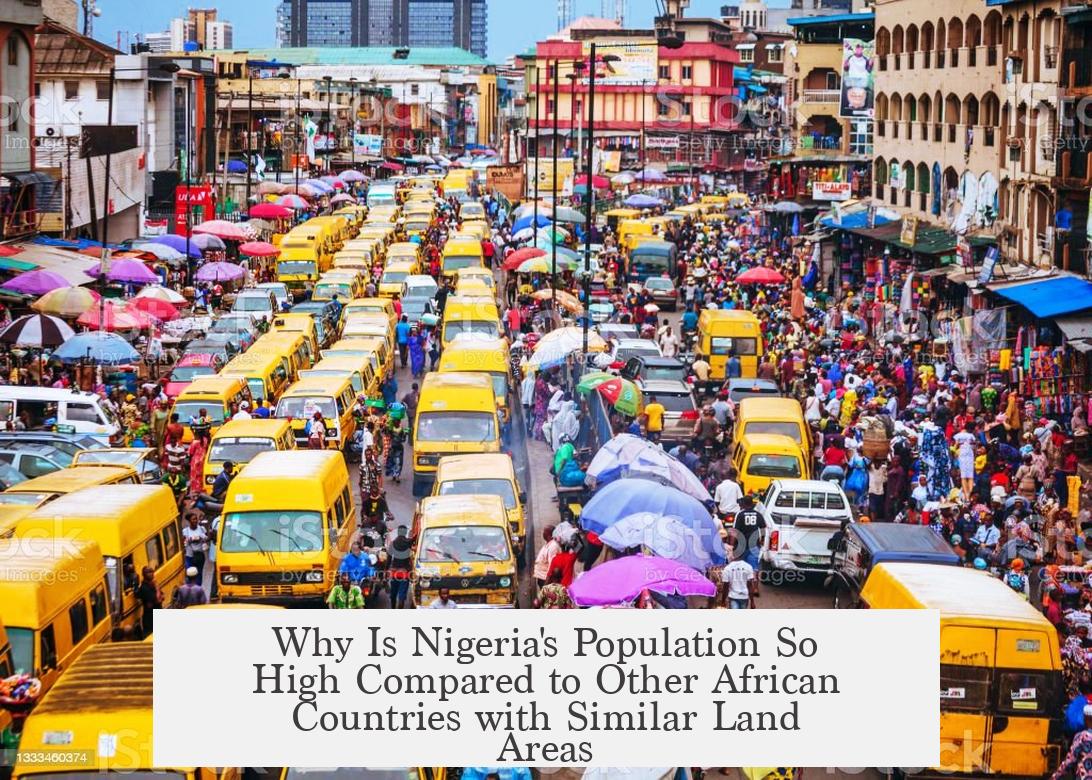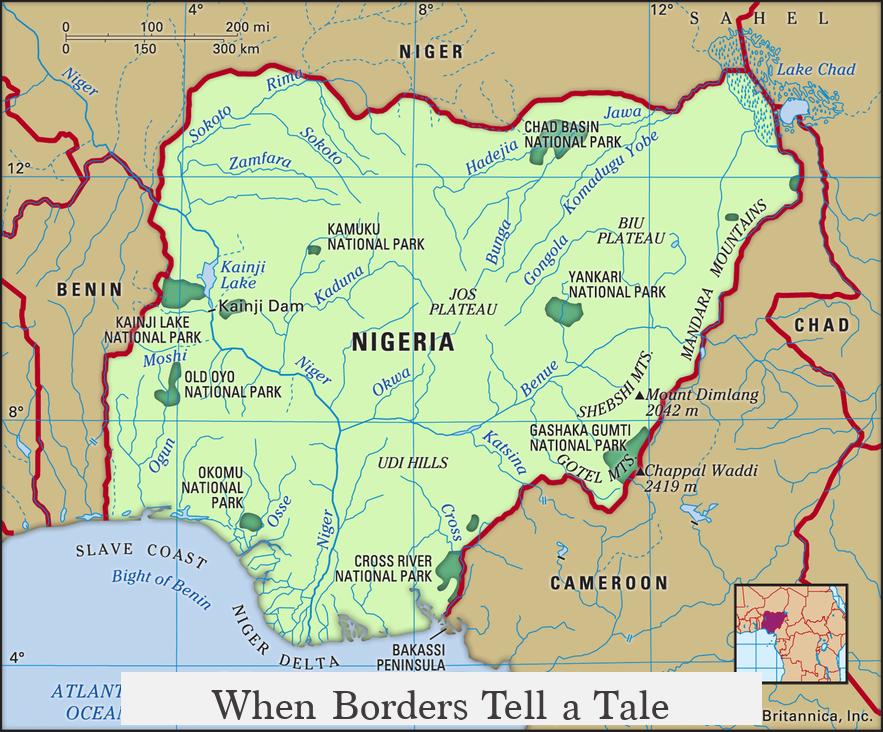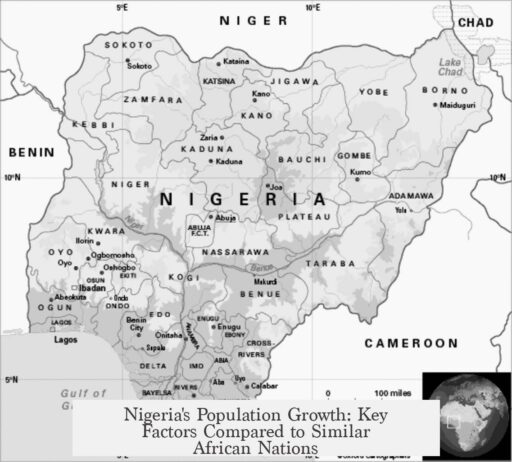Nigeria’s population is high compared to other African countries with similar land areas mainly due to its fertile river delta, extensive habitable land, and historical settlement patterns. The Niger River delta creates a rich ecological zone that supports dense communities. Additionally, Nigeria’s borders exclude vast low-density zones, maintaining a higher population density throughout.
The Niger River delta, where the river meets the Atlantic Ocean, creates a fertile and densely populated region. This contrasts with neighboring countries such as Ghana or Benin, which lack such a large, fertile delta. For instance, when the Biafra region (in the delta) attempted secession in the 1960s, it contained over 25% of Nigeria’s population but only about 8% of the country’s land area. This illustrates the population concentration supported by the delta’s ecology.
Moreover, Nigeria stretches into the Sahel zone—the semi-arid region south of the Sahara Desert. The Sahel, generally more habitable than the Sahara but less humid than southern forests, supports a relatively high population. This ecological zone acts as a “Goldilocks zone,” offering conditions suitable for human settlement and agriculture, despite stresses from climate change.
Political and colonial history also shaped Nigeria’s borders, which captured areas of high population density but exclude sparsely settled zones to the north. Neighboring Niger, largely desert, balances lower population density, but Nigeria’s borders limit such empty lands. Had these colonial borders differed, overall population density might appear less concentrated.
| Factor | Impact on Population Density |
|---|---|
| Niger River Delta | Highly fertile land supports dense populations |
| Sahel Zone | Moderate climate encourages settlement |
| Political Boundaries | Exclusion of low-density desert regions |
| Historical Settlement | Ancient cultures like Nok signal long-term habitation |
Compared to other African regions, Nigeria is not exceptionally dense in broader continental terms. Areas near Lake Victoria, the Nile Delta, and the Maghreb also feature dense populations. Nigeria’s density fits within the pattern of settlement around water and fertile lands, common across Africa.
- Fertile river deltas concentrate population.
- Sahel zone offers moderate climate for habitation.
- Colonial borders exclude low-density desert areas.
- Ancient culture suggests long-standing population centers.
- Density aligns with other fertile African regions.
Why Is Nigeria’s Population So High Compared to Other African Countries with Similar Land Areas?

Nigeria’s population is high primarily because of its rich river delta system, favorable ecological zones, and political boundaries that concentrate people rather than disperse them over vast, sparsely populated lands. Put simply, water, geography, and history combine to create this demographic powerhouse.
Let’s dive into why Nigeria’s population outpaces other African countries that look similar on a map but can’t hold a candle to its crowd.
The Magic of the Niger River Delta
Imagine a place so fertile and water-rich that it can support an astonishing number of people in a relatively small area. That’s Nigeria’s Niger River delta, an ecological gem that acts like a giant magnet for human settlement.
The delta is exceptionally densely populated. To put it into perspective, when the southeastern region called Biafra tried to secede in the 1960s, it occupied just 8% of Nigeria’s land but held over 25% of its population. That’s density packed into a slice of land that small!
Compare this to other West African countries with similar sizes like Ghana or Benin. They have river systems, but none quite as expansive, fertile, and navigable as Nigeria’s Niger delta. No wonder people cluster here—it’s a bit like the economic heartland rich in resources and sustenance.
Living on the Edge: The Sahel Zone
Nigeria is lucky—or unlucky, depending on your climate perspective—to straddle the Sahel, a semi-arid band that acts as a border between the Sahara Desert and the lush forests to the south.
This “Goldilocks zone” in the Sahel isn’t too dry nor too wet. Historically, it’s supported surprisingly dense populations. The climate allows for pastoralism, farming, and vibrant communities. Unlike pure desert or rainforest zones that limit population density, the Sahel offers a balance that sustains many.
Though climate change threatens the Sahel, for now, this ecological belt helps boost Nigeria’s overall population by expanding habitable and farmable lands northward.
When Borders Tell a Tale

Let’s get political—at least with borders.
Nigeria’s boundaries, drawn mostly by colonial scribes, have a certain population pattern advantage. They cut through diverse ecology but lack a vast zone of extremely low population density within the country.
Imagine if Nigeria had absorbed its northern neighbor Niger, which is dominated by desert and sparse populations. Its average density would plummet dramatically. Instead, Nigeria remains mostly clustered with vibrant population centers.
So, if you reshuffle borders to grab only Nigeria’s populated hotspots, you might find a country even denser than it is now. This means Nigeria’s political-geographic layout concentrates people rather than scattering them thin.
Nigeria in Continental Perspective
It’s tempting to say Nigeria’s population is an outlier. Turns out, it isn’t vastly more crowded than parts of Africa like the Nile delta, the Maghreb coast, or Lake Victoria’s shoreline.
Population clustering around fertile river systems is an old and widespread phenomenon. In this lens, Nigeria behaves like many ancient civilizations: settle near water and thrive.
So, Nigeria’s population density sits comfortably within established continental patterns. It’s akin to wondering why Japan has more people than Mongolia despite both being in Asia. Different geography, different histories.
History’s Imprint on Population Patterns
Diving deeper, Nigeria’s roots in human civilization go back millennia. It hosts sub-Saharan Africa’s oldest iron-working sites and the enigmatic Nok Culture, known for stunning terracotta statues. These ancient technological and cultural advances hint at early population centers capable of supporting communities.
Such advancements often correlate with higher population densities over time. Early mastery of iron tools, for example, can boost agriculture, hunting, and defense. This creates population-friendly conditions persisting through history.
Water: The Life Force Behind Nigeria’s Density

At the heart of the answer lies water. The Niger River’s basin is one of the world’s great river systems, fueling agriculture, transport, and settlement.
The abundance of water drives food production, job opportunities, and urbanization. Major cities thrive along this river or its delta, supporting millions. When you think about it, in many parts of the world, water dictates population spread, and Nigeria is no exception.
What Does This Mean for Nigeria’s Future?
Nigeria’s demographic edge brings both opportunities and challenges.
- High density can fuel economic growth if harnessed through infrastructure, education, and healthcare.
- But it also stresses resources like water and housing.
- Understanding why people settle where they do helps policymakers plan better urban centers and rural development.
If Nigeria can manage its geographic strengths wisely, this population boon can translate into a lasting advantage.
Final Thoughts: Is Nigeria’s Population Really Surprising?
When you place Nigeria into its full geographic, ecological, and historical context, its population seems less a mystery and more a natural outcome.
Rich river deltas, a balanced ecological zone between desert and forest, well-drawn borders, plus a deep cultural history all combine to create a densely inhabited land. The high numbers aren’t just about more people—they reflect the dynamic interaction of environment, history, and politics.
In the grand scheme, Nigeria’s population density stands as a vivid example of how humans adapt to and flourish in diverse landscapes. So next time you wonder why Nigeria busts population charts compared to similar-size neighbors, remember: it’s a story written by rivers, boundaries, and ages of human ingenuity.



